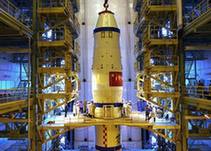9月23日上午,神舟七號載人航天飛行任務(wù)進行了發(fā)射場區(qū)最后一次船箭地聯(lián)合檢查,標志著“神七”載人飛船已進入發(fā)射倒計時。神舟七號載人航天飛行將于9月25日至30日擇機實施,首選9月25日21時10分。神舟七號飛船任務(wù)實施期間,飛行乘組中1名航天員將出艙進行太空行走,并完成有關(guān)空間科學實驗操作。這將是中國人首次在太空中漫步。

|

|
|
Technicians help the Shenzhou VII spacewhip dock with the Long-March II-F rocket at an assembly plant in Jiuquan, Gansu province. [Xinhua]
|
The first Chinese astronaut is likely to walk in space around 4:30 pm on Friday, a day after spacecraft Shenzhou VII lifts off, the commander-in-chief of the mission's ground operation has said.
The historic moment will be broadcast live across the world, xinhua.net quoted Cui Jijun as having said on Tuesday, and the space environment is expected to be fine for the mission.
Shenzhou VII is scheduled to blast off from Jiuquan in Gansu province tomorrow night. The exact time will be announced on Wednesday.
The Shenzhou-VII mission entered the countdown stage after the final check on the spacecraft, the carrier rocket and the ground operation system was completed Tuesday morning.
Scientists simulated the ignition of the rocket and the in-flight moves of the capsule to test how the observation, control and communication systems at the Jiuquan Satellite Launch Center work.
The rocket will be loaded with fuel after an overall quality review and approval of the mission headquarters. And all the settings of the spacecraft and the observation, control and communication systems will be frozen till the launch.
The spacecraft, its Long-March II-F carrier rocket and the escape tower were fitted on the launch pad on Saturday.
Technicians checked the rocket and the spacecraft on Monday to test how it functioned, Cui said. "All work well."
The space environment will be stable and calm during the mission, the Center for Space Environment Research and Forecast (CSERF), affiliated to the Chinese Academy of Sciences, said.
"After analyzing all the conditions, we predict that the space environment will be safe for the launch and the spacewalk," Liu Siqing, CSERF deputy director, said.
Starting from Tuesday, the center will submit a report on space environment and all operation systems to the headquarters every day till the completion of mission, Liu said.
The report will cover high-energy electrons, high-energy protons, X-rays and geomagnetic fields, which could affect the spaceship's flight.
Huang Weifen, deputy chief designer of the mission's flight system, said six astronauts - three to fly out and three to be on standby - have reached Jiuquan on Sunday. One of the three on the spaceship will conduct the spacewalk.
The six astronauts have been housed in a guarded quarantine facility, she said.
Other mission staff have to wear masks and sterilized uniforms and undergo health checks before entering the compound, and cannot even shake hands with the astronauts.
Doctors on the compound are closely monitoring the astronauts' physical and psychological states, she said.
All the five satellite-tracking ships are in position to support China's first spacewalk mission. Four of the vessels are in the Pacific Ocean and one in the Atlantic.
Jian Shilong, director of China Maritime Tracking and Control Department, said the ships would track and support Shenzhou VII, and monitor the spacewalk.
The ships, which can control the shuttle's solar panels, its orbit maneuverings and help with its maintenance, are part of China's space telemetry network, which comprises about 20 terrestrial surveying stations, too.
A new purpose-built media center will be opened in Beijing tomorrow for overseas journalists covering China's first spacewalk mission. This is the first time the country will open its space mission to the foreign media.
(China Daily)

(英語點津 Helen 編輯)